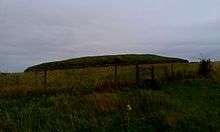Stoney Littleton Long Barrow
The Stoney Littleton Long Barrow (also known as the Bath Tumulus and the Wellow Tumulus) is a Neolithic chambered tomb with multiple burial chambers, located near the village of Wellow in the English county of Somerset. It is an example of the Cotswold-Severn Group and was scheduled as an ancient monument in 1882. It was one of the initial monuments included when the Ancient Monuments Protection Act 1882 became law.[1]
 Stoney Littleton Long Barrow in 2016 | |
 Shown within Somerset | |
| Alternative name | Bath Tumulus and Wellow Tumulus |
|---|---|
| Location | near Wellow |
| Region | Somerset, England |
| Coordinates | 51°18′48″N 2°22′54″W |
| Type | Chambered long barrow |
| History | |
| Periods | Neolithic |
| Site notes | |
| Condition | intact |
| Public access | yes |
The chambered long barrow was built around 3500 BC. Excavations in the early 19th century uncovered bones from several individuals. The stone structure is about 30 metres (98 ft) in length and contains a 12.8 metres (42 ft) long gallery with three pairs of side chambers and an end chamber.
Location and access
The barrow is approximately 1.5 kilometres (0.93 mi) south west of the village of Wellow. It is on a limestone ridge overlooking Wellow Brook approximately 200 metres (660 ft) to the north and west of the barrow.[2] It is surrounded by a rectangular grass area accessed via a stile and footpath from a car park at Stoney Littleton Farm.[3]
History
Chambered long barrows were constructed during the Neolithic between 4000 and 2500 BC for the ritual inhumation of the dead.[4] Stoney Littleton Long Barrow was probably constructed around 3500 BC.[5]
The tomb was first opened around 1760 by a local farmer to obtain stone for road building.[5][6] The site was excavated by John Skinner and Richard Hoare in 1816-17, along with a labourer Zebedee Weston[7], who gained the entry through the hole which was made previously.[4] The excavation revealed the bones (some burned) of several individuals.[5] The mound was restored in 1858 by Thomas Joliffe.[2] Some of the artefacts from the excavations are in the Bristol City Museum and Art Gallery.[3]
It was scheduled as an ancient monument in 1882.[8] Since 1884 the Stoney Littleton Long Barrow has been in state care,[8] and is now managed by English Heritage who have provided an information board at the site.[5] Further conservation work and a geophysical survey were carried out in 1999 and 2000 by the Cotswold Archaeological Trust.[2]
Description
Severn-Cotswold tombs consist of precisely-built, long trapezoid earth mounds covering a burial chamber.[9] The Stoney Littleton Long Barrow stands on a limestone ridge overlooking Wellow Brook and the village of Wellow.[10] It is constructed from stone, including Blue Lias and Forest Marble quarried within an 8 kilometres (5.0 mi) radius.[2][3][5]
It is about 30 metres (98 ft) in length and 15 metres (49 ft) wide at the south-east end, it stands nearly 3 metres (10 ft) high.[8] Internally it consists of a 12.8 metres (42 ft) long gallery with three pairs of side chambers and an end chamber.[4] The passage and entrance are roughly aligned towards the midwinter sunrise.[11] The roof is made of overlapping stones.[12] There is a fossil ammonite impression decorating the left-hand doorjamb.[13][14]
Unusually, the barrow is not situated on flat ground and "looks as though it is sliding down the side of a hill."[3]
Gallery
- The entrance
 The impression of an ammonite at the entrance to the barrow
The impression of an ammonite at the entrance to the barrow The chamber
The chamber Curved back
Curved back The entrance
The entrance The back end
The back end Disfigured plaque
Disfigured plaque- The interior
References
- Fry, Sebastian. "A History of the National Heritage Collection. Volume One: 1881-1900" (PDF). English Heritage. p. 46. Retrieved 15 February 2015.
- Historic England. "Stoney Littleton Long Barrow (203075)". PastScape. Retrieved 20 January 2015.
- Darvill, Timothy. "Stoney Littleton Long Barrow, Wellow, Bath and North East Somerset". Digital Digging. Retrieved 20 January 2015.
- "Stoney Littleton Long Barrow Department of the Environment Guide Book 1982". Bath and North East Somerset Council. Archived from the original on 2 March 2008. Retrieved 20 January 2015.
- "History and Research: Stoney Littleton Long Barrow". English Heritage. Retrieved 20 January 2015.
- Maclean, John (1980). "Description of the Chambered Tumuli of Uley and Mympsfield". Transactions of the Bristol and Gloucestershire Archaeological Society. V: 108–111.
- "The Reverend John Skinner. Amateur archaeologist and vicar of Camerton between 1800 and 1839". The Heritage Journal. 3 August 2010. Retrieved 21 July 2018.
- Historic England. "Stoney Littleton long barrow (1007910)". National Heritage List for England. Retrieved 22 October 2014.
- Dunn, Richard (2004). Nempnett Thrubwell:Barrows, Names and Manors. Nempnett Books. pp. 33–62. ISBN 0-9548614-0-X.
- Scott, Shane (1995). The hidden places of Somerset. Aldermaston: Travel Publishing Ltd. p. 16. ISBN 1-902007-01-8.
- Lewis, Jodie (2008). "The Long Barrows and Long Mounds of West Mendip" (PDF). Proceedings of the Bristol Spelaeological Society. 24 (3): 187–206.
- Carter, Katy (2004). Heritage Unlocked: Guide to free sites in Devon, Dorset and Somerset. English Heritage. pp. 84–85. ISBN 978-1850748755.
- "Stoney Littleton". Stone circles. Retrieved 20 January 2015.
- Darvill, Timothy (2010). "Megaliths, Monuments, and Materiality". Paper of the European Megalithic Studies Group: 8.
External links
| Wikimedia Commons has media related to Stoney Littleton Long Barrow. |
- "Stoney Littleton Long Barrow". English Heritage. Retrieved 9 August 2017.
- QuickTime Virtual Reality Video